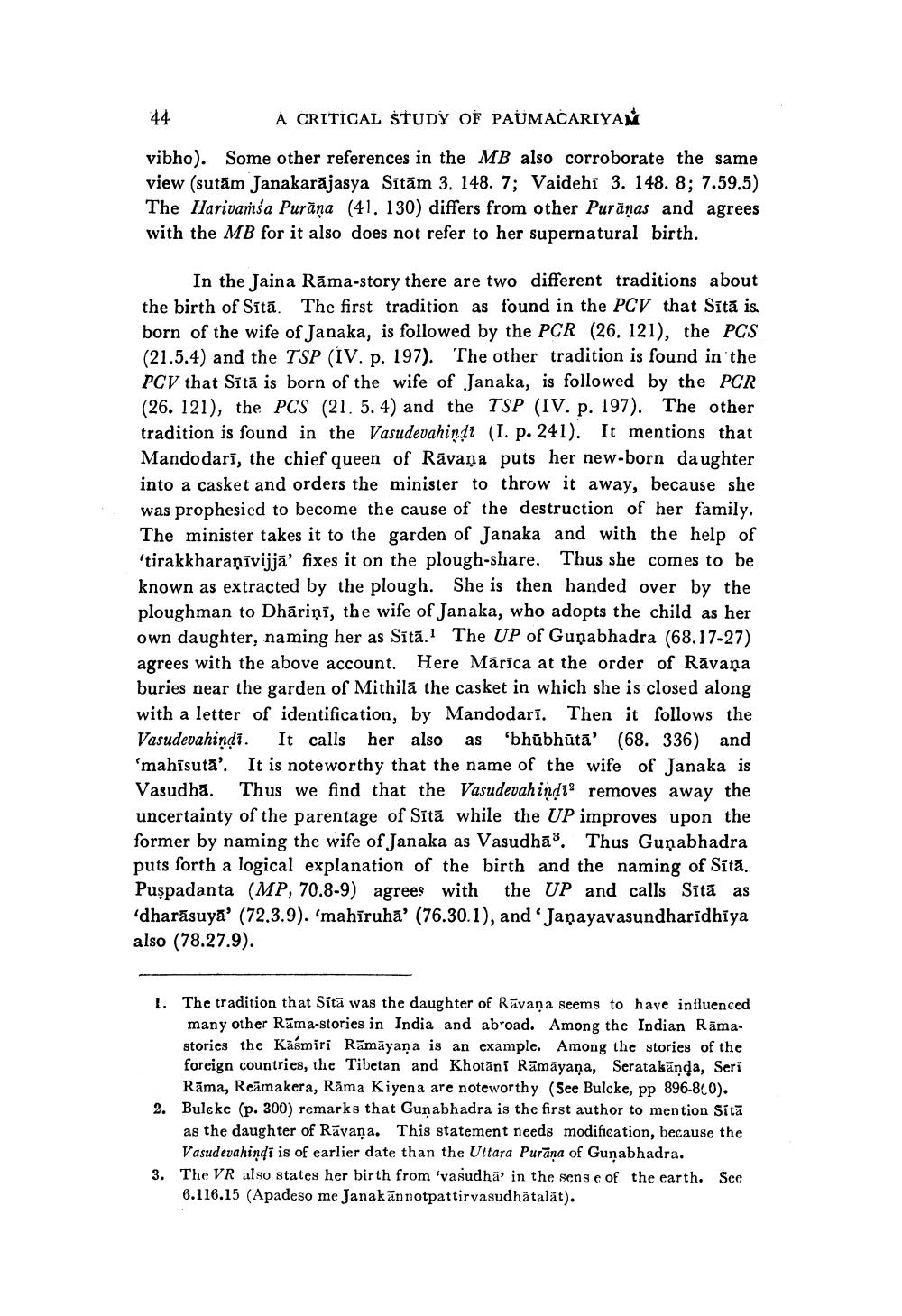________________
44
A CRITICAL STUDY OF PAUMACARIYAM
vibho). Some other references in the MB also corroborate the same view (sutām Janakarājasya Sītām 3. 148. 7; Vaidehi 3. 148. 8; 7.59.5) The Harivamsa Purana (41. 130) differs from other Puranas and agrees with the MB for it also does not refer to her supernatural birth.
In the Jaina Rama-story there are two different traditions about the birth of Sītā. The first tradition as found in the PCV that Sīta is. born of the wife of Janaka, is followed by the PCR (26, 121), the PCS (21.5.4) and the TSP (IV. p. 197). The other tradition is found in the PCV that Sītā is born of the wife of Janaka, is followed by the PCR (26. 121), the PCS (21. 5. 4) and the TSP (IV. p. 197). The other tradition is found in the Vasudevahindi (I. p. 241). It mentions that Mandodari, the chief queen of Ravana puts her new-born daughter into a casket and orders the minister to throw it away, because she was prophesied to become the cause of the destruction of her family. The minister takes it to the garden of Janaka and with the help of 'tirakkharaņīvijjā' fixes it on the plough-share. Thus she comes to be known as extracted by the plough. She is then handed over by the ploughman to Dhāriņī, the wife of Janaka, who adopts the child as her own daughter, naming her as Sītā.1 The UP of Gunabhadra (68.17-27) agrees with the above account. Here Marica at the order of Ravana buries near the garden of Mithila the casket in which she is closed along with a letter of identification, by Mandodari. Then it follows the Vasudevahindi. It calls her also as 'bhubhūtā' (68. 336) and 'mahīsută'. It is noteworthy that the name of the wife of Janaka is Vasudha. Thus we find that the Vasudevahindi removes away the uncertainty of the parentage of Sita while the UP improves upon the former by naming the wife of Janaka as Vasudha3. Thus Gunabhadra puts forth a logical explanation of the birth and the naming of Sītā. Puspadanta (MP, 70.8-9) agrees with the UP and calls Sītā as 'dharasuya' (72.3.9). 'mahīruha' (76.30.1), and 'Janayavasundharīdhīya also (78.27.9).
1. The tradition that Sita was the daughter of Ravana seems to have influenced many other Rama-stories in India and abroad. Among the Indian Ramastories the Kasmiri Rāmāyaṇa is an example. Among the stories of the foreign countries, the Tibetan and Khotānī Rāmāyaṇa, Seratakāṇḍa, Seri Rāma, Reämakera, Rama Kiyena are noteworthy (See Bulcke, pp. 896-80).
2. Bulcke (p. 300) remarks that Gunabhadra is the first author to mention Sita as the daughter of Ravana. This statement needs modification, because the Vasudevahindi is of earlier date than the Uttara Purana of Gunabhadra.
3. The VR also states her birth from 'vasudha' in the sens e of the earth. See 6.116.15 (Apadeso me Janak annotpattirvasudhätalät).




